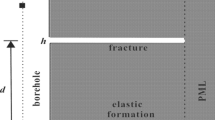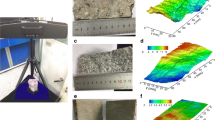Abstract
In this paper, the finite difference method is used to model the Stoneley wave reflection by a horizontal fracture in a borehole. The fracture shape is described by some finite difference grids. Therefore, the fracture aperture can be varied in the radial direction, thus extending previous researches on the assumption that the fracture aperture is constant throughout the fracture. Finite difference grids can also be used to describe a fracture which extends a finite distance in the radial direction. In addition, the finite difference algorithm can deal with the problem of inhomogeneous formation. Therefore, it allows the variation of formation elasticity in the model. Fine grids are needed to describe the small fracture aperture, and variable grid spacing is employed by finite difference method to improve computational efficiency. The Stoneley wave propagation is simulated by the variable grid spacing finite difference method in several models with variable fracture aperture, finite extension fracture and models with heterogeneous formation. The variable grid spacing finite difference method is validated through a comparison with real axis integration method and the analytical method. We get some conclusions by simulating and investigating effects of the variation of fracture aperture, the fracture of finite extension and inhomogeneity of formation on the Stoneley wave reflection. Although the fracture aperture changes along the fracture extension direction, the reflection coefficient of Stoneley wave is mainly controlled by the fracture aperture near the borehole. The Stoneley wave in the fracture is reflected back into the borehole, by the tip of finite extension fracture, which results in some notches in the reflection coefficient curve. If the Stoneley wave propagates from the formation with small elastic modulus to the formation with large elastic modulus, the reflection coefficient of Stoneley wave will be larger than that of homogeneous model with small elastic modulus. And if Stoneley wave propagates from the formation with large elastic modulus to the formation with small elastic modulus, the reflection coefficient of Stoneley wave will be smaller that of homogeneous model with large elastic modulus. These results provide some basis for the use of Stoneley wave to detect the fracture properties in formation.















Similar content being viewed by others
References
Alford RM, Kelly KR, Boore DM (1974) Accuracy of finite-difference modeling of the acoustic wave equation. Geophysics 39(6):834–842
Aoi S, Fujiwara H (1999) 3D finite-difference method using discontinuous grids. Bull Seismol Soc Am 89(4):918–930
Bakku SK, Fehler M, Burns D (2011) Fracture characterization from tube waves in boreholes. Trans Geotherm Resour Counc 35:1617–1622
Bakku SK, Fehler M, Burns D (2013) Fracture compliance estimation using borehole tube waves. Geophysics 78:D249–D260
Bohlen T, Saenger EH (2006) Accuracy of heterogeneous staggered-grid finite-difference modeling of Rayleigh waves. Geophysics 71:T109–T115
Brown SR, Scholz CH (1985) Broad bandwidth study of the topography of natural rock surfaces. J Geophys Res Solid Earth 90(B14):12575–12582
Brown SR, Kranz RL, Bonner BP (1986) Correlation between the surfaces of natural rock joints. Geophys Res Lett 13(13):1430–1433
Chang HW, Randall CJ (1988) Finite-difference time-domain modeling of elastic wave propagation in the cylindrical coordinate system. In: IEEE 1988 ultrasonics symposium proceedings. IEEE, pp 397–402
Falk J, Tessmer E, Gajewski D (1996) Tube wave modeling by the finite-difference method with varying grid spacing. Pure Appl Geophys 148(1–2):77–93
Frehner M, Schmalholz SM (2010) Finite-element simulations of Stoneley guided-wave reflection and scattering at the tips of fluid-filled fractures. Geophysics 75(2):T23–T36
Groenenboom J, Falk J (2000) Scattering by hydraulic fractures: finite-difference modeling and laboratory data. Geophysics 65:612–622
Hellwig O, Geerits TW, Bohlen T (2011) Accuracy of 2.5 D seismic FDTD modeling in the presence of small scale borehole structures. In: 73rd EAGE conference and exhibition incorporating SPE EUROPEC 2011
Hornby BE, Johnson DL, Winkler KW, Plumb RA (1989) Fracture evaluation using reflected Stoneley-wave arrivals. Geophysics 54:1274–1288
Hornby BE, Luthi SM, Plumb RA (1992) Comparison of fracture apertures computed from electrical borehole scans and reflected Stoneley waves: an integrated interpretation. Log Anal 33(01):50
Ionov AM (2007) Stoneley wave generation by an incident P-wave propagating in the surrounding formation across a horizontal fluid-filled fracture. Geophys Prospect 55:71–82
Kostek S, Johnson DL, Randall CJ (1998a) The interaction of tube waves with borehole fractures. Part I: Numerical models. Geophysics 63:800–808
Kostek S, Johnson DL, Winkler KW, Hornby BE (1998b) The interaction of tube waves with borehole fractures. Part II: Analytical models. Geophysics 63:809–815
Moczo P (1989) Finite-difference technique for SH-wave in 2-D media using irregular grids application to the seismic response problem. Geophys J Int 99:321–329
Pitarka A (1999) 3D elastic finite-difference modeling of seismic motion using staggered grids with nonuniform spacing. Bull Seismic Soc Am 89:54–68
Randall CJ, Scheibner DJ, Wu PT (1991) Multipole borehole acoustic waveforms: synthetic logs with beds and borehole washouts. Geophysics 56(11):1757–1769
Spring CT, Dudley DG (1992) Acoustic wave propagation in a cylindrical borehole with fractures. J Acoust Soc Am 91:658–669
Stephen RA, Cardo-Casas F, Cheng CH (1985) Finite-difference synthetic acoustic logs. Geophysics 50:1588–1609
Tang XM (1990) Acoustic logging in fractured and porous formations. Sc.D. thesis, Massachusetts Institute of Technology
Tang XM, Cheng CH (1993) Borehole Stoneley wave propagation across permeable structures. Geophys Prospect 41:165–187
Tsang L, Rader D (1979) Numerical evaluation of the transient acoustic waveform due to a point source in a fluid-filled borehole. Geophysics 44:1706–1720
Virieux J (1986) P-SV wave propagation in heterogeneous media: Velocity-stress finite-difference method. Geophysics 51:889–901
Wang T, Tang X (2003) Finite-difference modeling of elastic wave propagation: a nonsplitting perfectly matched layer approach. Geophysics 68(5):1749–1755
Wu CL, Harris JM, Nihei KT, Nakagawa S (2005) Two-dimensional finite-difference seismic modeling of an open fluid-filled fracture: comparison of thin-layer and linear-slip models. Geophysics 70:T57–T62
Yan SG, Xie FL, Gong D, Zhang CG, Zhang BX (2015) Borehole acoustic fields in porous formation with thin fracture. Chin J Geophys 58:307–317
Acknowledgements
The work described in this paper is supported by the National Natural Science Foundation of China (No. 41874135).
Author information
Authors and Affiliations
Corresponding author
Rights and permissions
About this article
Cite this article
Ou, W., Wang, Z., Ning, Q. et al. Numerical simulation of borehole Stoneley wave reflection by a fracture based on variable grid spacing method. Acta Geophys. 67, 1119–1129 (2019). https://doi.org/10.1007/s11600-019-00309-y
Received:
Accepted:
Published:
Issue Date:
DOI: https://doi.org/10.1007/s11600-019-00309-y




